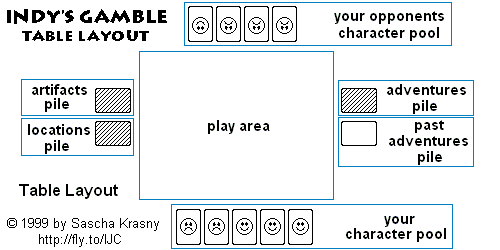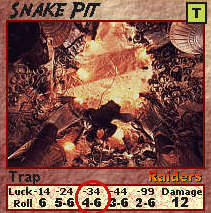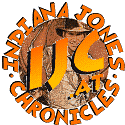| 1) |
The game
This game is for two players. The goal of the game is to add five artifact cards
to your collection before your opponent does. To get an artifact you have to find one and get away without
being stopped by your opponent. Or you simply steal one from your opponent. |
| 2) |
To play this game you need ...
... the 84 cards from the Indy's Gamble set
... one six sided dice
... the damage counters from the Indy's Gamble set (only if you want to)
... skill and some luck :) |
| 3) |
Card types
Characters ... There are 12 good friends and 12 evil foes.
Equipment ... You can arm your characters with 12 different
weapons, speed them up with 12 vehicles and set 12 lethal traps for your opponent.
Treasures ... 12 artifacts hidden in 12 locations are waiting
to be discovered. |
| 4) |
Game setup |
| |
a)
|
Make three piles of cards:
- The adventures pile consists of all character and equipment cards.
- The artifacts pile consists of the artifacts
cards.
- The locations pile consists of the locations
cards.
All three piles must be shuffled well and be placed face down on the table. There will be a fourth pile during
the game named past adventures pile. All cards that have
been used and are no longer in play are placed onto that
pile. |
| |
b)
|
Both players draw six cards from the adventures pile. |
| |
c)
|
Use the dice to find out who will start the game. |
|

|
| 5) |
Game play
The game is played in turns. Each turn one player is the active player. A turn consists of 5 steps. |
| |
1.
|
The Preparations
The active player draws a card from the adventure pile, then the second player draws a card from the adventure pile. |
| |
2.
|
The Search
If you want to search for an artifact,
proceed with step 2. Otherwise skip to step 5. |
| |
|
a)
|
Choose a leading character from your character pool. Your character pool is the amount of character cards that you have
placed on the table in former turns. Additional characters
can join your leading character later. |
| |
|
b)
|
Draw a card from the locations pile and
lay it face up on the table to see where your search will lead you. |
| |
|
c)
|
Now your opponent can put any number of trap cards from his or her hand face down on the table. |
| |
|
d)
|
Now your party has to face the traps one
by one with a test of luck. If the Location is booby trapped
start with this trap otherwise turn the placed traps face up to encounter them. Any time before or after a test of luck (but not during the test!) you can ...
... add any number of characters of the same type (friend or foe) than
your leading character from your character
pool to your party.
... play any number of equipment cards from your hand onto
your character cards in play to modify their character values.
Example:
Equip the character Indy with the weapon card Whip.
1) Indy's character values are:
» Attack: 13, Defence: 15, Speed: 14, Luck: 15 and Mystery: 12
2) Lay the weapon card Whip from your hand on the Indy card. The Whip has the following values:
» Attack: +5, Defence +4, Speed: -4, Luck: +2 and Mystery: 0
3) The modified character values of Indy are now:
» Attack: 18, Defence: 19, Speed: 10, Luck: 17 and Mystery: 12 |
|
| |
|
e)
|
For the test of luck you have to add up
all the luck values of your characters and equipment cards in play. Now read the trap card to find out what numbers will let you pass the test. Search for
the range your partys total luck
value fits in and you see the numbers below. Now roll the dice and see if you have
been able to pass the test.
Example:
 Indy (equipted with his Whip) and Marion are pushed into the Snake Pit (trap). Indy (equipted with his Whip) and Marion are pushed into the Snake Pit (trap).
1) Add up your characters' luck values: 15 (from Indy) + 2
(from the Whip) + 12 (from Marion) = 29
2) Read the luck value ranges on the Snake
Pit trap card. The fitting value range is marked with a red circle. It says if your
total luck points are between 25 and 34 you have to roll a 4, a 5, or a 6 to pass the test.
3) Hope for the best. Roll the dice. |
|
| |
|
f)
|
If you...
... passed the test put the trap on the past adventures pile
and proceed with the next trap. If you're through with all
traps, draw a card from the artifacts
pile and lay it face up in front of you.
... failed the test your characters have to face the damage from the trap.
Damage is always assigned by your opponent and the damage of one trap
can only be assigned to one character. Any character that gets more damage points than his or her defence value must leave the play. Place the character card onto the past adventure pile. As long as there
are characters left proceed with the next trap. If you're through with all traps and there are still characters left, draw a
card from the artifacts pile and place it face up in front
of you.
Tips & Tricks:
Damage point are not removed from a character card until the end of the turn. To memorize the
damage use some counters or coins (like dimes for 1 point of damage and quaters for 5 points of damage). Or make
it even easier and put the trap card that did the damage under the character card as a marker. |
|
| |
3.
|
The Chase
If your opponent does not want to chase you add the artifact to your collection and skip to step 5. Otherwise proceed with step 3. |
| |
|
a)
|
Your opponent chooses a leading character
from his or her character pool. This character must be of the opposite type (friend or foe) than your leading character. Additional characters can join the leading character later. |
| |
|
b)
|
Both players may equip their party with
more weapons and vehicles or add more characters to their party. Weapon and
vehicle cards are always played onto one of the players'
own character cards and modify this character's values. Beware not to reduce a character's defence value
below 1 because a character with a defence
value of less than 1 must leave the play. If a character leaves play all weapons and vehicles
played on him or her also leave the play. Proceed when both
players are finished. |
| |
|
c)
|
Both players add up the total speed value
of their character cards (with the equipment modifications). If the total speed value of
your party is ...
... higher than your oppontent's party value your characters have been able to escape with
the artifact. Add the artifact
to your collection and skip
to step 5.
... lower than your oppontent's party value there will be a fight.
Example:
Your party Indy (with his Whip) and Marion
are chased by Belloq and the German
Mechanic.
1) To speed your party up you put a Horse card on Indy.
2) Add up your characters total speed values: 14 (from Indy) -4
(from the Whip) +6 (from the Horse) +
11 (from Marion) = 27
3) To speed up his party your opponent puts a Truck card on Belloq.
4) Your opponent adds up his characters total speed values:
12 (from Belloq) +7 (from the Truck) + 8 (from the German Mechanic)
= 27
5) Your characters are not faster than those from your opponent, they will have to
fight. |
|
| |
4.
|
The Fight |
| |
|
a)
|
Both players may equip their party with
more weapons and vehicles or add more characters to their party. Proceed when both players are finished. |
| |
|
b)
|
Now assign all the attack values of your
characters (modified by the equipment used) as damage to your opponents characters. There is one basic rule: Each amount from one of your character cards must be assigned completely
on an opposing character. You cannot split up the damage
to harm two or more opposing characters. Of course two or
more of your characters can harm one opposing
character. |
| |
|
c)
|
Before any damage takes effect your opponent
assigns the damage his party will do to your characters. |
| |
|
d)
|
Now the damage takes effect. Any character that gets more damage points than his or her defence value must leave the play. Place those cards on the past
adventures pile.
Example:
Your party Indy (with his Whip and a Horse)
and Marion must fight Belloq (with a Truck) and the German
Mechanic.
1) You play the weapon card Revolver on Indy and the weapon card Flying Wing on Marion.
2) Assign your characters attack values: 13 (from Indy) + 5 (from the Whip) - 4 (from the Horse) + 7
(from the Revolver) = 21 to the German
Mechanic and 7 (from Marion)
+ 10 (from the Flying Wing) = 17 to Belloq.
3) Your opponent plays no weapon or vehicle cards on his characters.
4) Your opponent assigns his characters attack values: 12 (from Belloq) -6 (from the Truck) = 6 to Marion and 17 (from the German Mechanic) also to Marion.
5) Indy (Defence 27) got no damage, Marion (Defence 11) got 23 points of damage, Belloq (Defence 16) got 17 points of damage and the German
Mechanic (Defence 14) got 21
points of damage. Marion, Belloq and the German Mechanic must leave the play. |
|
| |
|
e)
|
Now there are three possible situations:
- Only one party is left: The player who owns that party can add the artifact
in his or her collection.
- No characters are left: The artifact gets lost and is placed onto the past adventures pile.
- At least one character from each party is still in play: Put the artifact aside as
a jackpot for the next turns. Whoever wins the next artifact
gets this one too. |
| |
5.
|
The Clean Up |
| |
|
a)
|
All your characters still in play return
to their players character pool and heal completly (any
damage points are removed). |
| |
|
b)
|
All cards left on the table (used or unused traps,
the location, all used weapons and vehicles) are placed on the past adventures pile. |
| |
|
c)
|
Lay down as many new characters into you
character pool as you want available for action in further
turns. |
| |
|
d)
|
If you have more than six cards discard them down to six cards to the past
adventures pile. |


